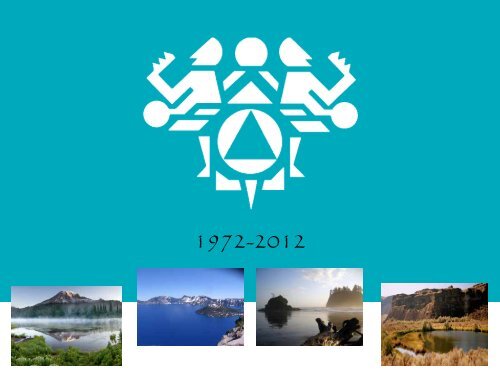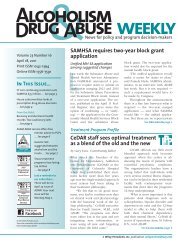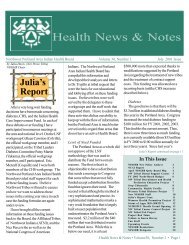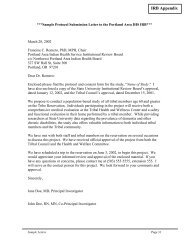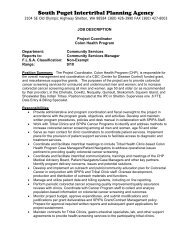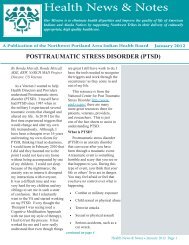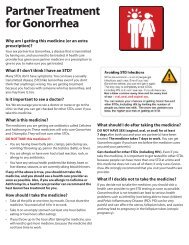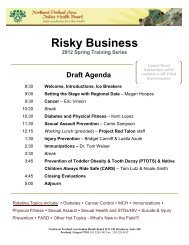See the NPAIHB 40th Anniversary Photo Book (5.5mb PDF)
See the NPAIHB 40th Anniversary Photo Book (5.5mb PDF)
See the NPAIHB 40th Anniversary Photo Book (5.5mb PDF)
Create successful ePaper yourself
Turn your PDF publications into a flip-book with our unique Google optimized e-Paper software.
5EXECUTIVE SUMMARY / INTRODUCTION7<strong>NPAIHB</strong> EXECUTIVE DIRECTORS11NW TRIBAL MAPS15RESOLUTIONS19COMMUNITY23PEOPLE27WORK33VISION FROM THE PAST
Mission StatementOur Mission is to eliminate health disparities and improve <strong>the</strong> quality of life of AmericanIndians and Alaska Natives by supporting Northwest Tribes in <strong>the</strong>ir delivery of culturallyappropriate, high quality healthcare.AcknowledgmentsWe would like to express our greatest gratitude to <strong>the</strong> people who have helped & supportedus throughout <strong>the</strong> development of <strong>the</strong> Board history. We are grateful to <strong>the</strong> leaders from<strong>the</strong> forty three Northwest Tribes who have supported <strong>the</strong> Board, from initial advice in <strong>the</strong>early years of conceptual inception and through ongoing guidance and encouragement tothis day.Thank you to our Delegates from each of <strong>the</strong> forty three Northwest Tribes for providing uswith continued direction and continued input on <strong>the</strong> urgency of our work.Ruby Beach, Quinault, Wa.PHOTO CREDITSAll <strong>the</strong> black and white and color photography for thisbook was kindly provided by <strong>the</strong> Northwest Portland AreaIndian Health Board except where individually creditedA special thanks goes to my colleagues, Erik Kakuska (Zuni), Elaine Dado (RosebudSioux), Jim Roberts (Hopi, Sioux) and Victoria Warren-Mears, who helped in completing<strong>the</strong> project“Humankind has not woven <strong>the</strong> web of life. We are but one thread within it.Whatever we do to <strong>the</strong> web, we do to ourselves. All things are bound toge<strong>the</strong>r.All things connect.”~ Chief Seattle4
Executive Summary / IntroductionJoe Finkbonner (Lummi)2005 - PresentI am both honored and flattered to have been asked to be <strong>the</strong> Executive Director for <strong>the</strong> Northwest Portland Area Indian HealthBoard (<strong>NPAIHB</strong>). The <strong>NPAIHB</strong> is known nationally for <strong>the</strong> quality of work that it produces on behalf of ALL tribes, even though our focus is <strong>the</strong>improvement in <strong>the</strong> health status of our member tribes and <strong>the</strong>ir communities.I congratulate each of you for your contributions toward <strong>the</strong> <strong>NPAIHB</strong>’s success, it is because of <strong>the</strong> leadership that our Northwest tribes have thatleads to <strong>the</strong> high expectations for <strong>the</strong> organization. It is also <strong>the</strong> joining of 43 tribes of diverse geography, diverse languages and cultural practices, andmore contemporarily diverse choices in operation of health systems that has made our individual efforts symbiotic and often a catalyst for nationalmovements.Your achievements in <strong>the</strong> realms of Indian Health are a model for all tribes and o<strong>the</strong>r Area Health Boards. The NW is a leader in progressive thinkingthat has put our tribes in <strong>the</strong> first tier of; tribal self determination, tribally operated epidemiology center, model tribal-state relations, national diabetesprograms, NW leaders in officer positions on National Indian Organizations.A time such as this should also give us pause to think about <strong>the</strong> leaders who are no longer with us, but are a vital part of who we are today. Leaders suchas Joe DeLaCruz, Violet Hillaire, Corrine Hicks, Rod Smith, Susan Wilbur, and <strong>the</strong> losses of family members who are <strong>the</strong> support network for ourtribal leaders. I take this time and honor <strong>the</strong>ir contributions and <strong>the</strong> foundation <strong>the</strong>y have provided for our organization…our families.5
Dave Lambert1973 - 1976Felicia Schanche Hodge,(Wailaki)1976 - 1983My experience as <strong>the</strong> Executive Director of <strong>the</strong> <strong>NPAIHB</strong>grounded me with an education and experience that guided me throughoutmy personal and professional career. During my tenure, I testified beforeCongress, developed strategic plans, developed <strong>the</strong> Board training manual,and obtained developmental funds to support <strong>the</strong> training of CHRs, tribalpersonnel and clinic staff. Because of <strong>the</strong>ir vision and dedication to <strong>the</strong>tri-state tribal groups, <strong>the</strong> Board directed me to establish a strong, fiscallysecure agency. I incorporated <strong>the</strong> Board, developed a powerful accountingsystem, and secured funds from <strong>the</strong> IHS, Federal NIH and o<strong>the</strong>r sources.The <strong>NPAIHB</strong> is to be commended during this 40-year celebration for itshistory as a visionary and advocacy agency. The tribe’s collective vision 40years ago was on target –advocating for American Indian health, socialwelfare, and tribal sovereignty – establishing a strong agency, representingall in <strong>the</strong> Northwest– and taking on <strong>the</strong> leadership for supporting legislationand securing patient rights in a culturally competent manner is witness to<strong>the</strong>ir success. The Northwest leaders of today continue in <strong>the</strong> path set bypast leaders to secure an agency that can make a difference in education,healthcare, and wellness. A plan for financial integrity, a goal of welltrainedleaders and staff, and a strong collaboration with NW tribes set<strong>the</strong> framework for a stable organization that stood <strong>the</strong> test of time.Looking back over <strong>the</strong> years, I am grateful for <strong>the</strong> kindness of <strong>the</strong> elderswho often “had a talk” with me, <strong>the</strong> CHRs who had bake sales to travel withme to Washington DC to support our testimony, and <strong>the</strong> Chairman of <strong>the</strong><strong>NPAIHB</strong>, Mel Sampson (Yakima) who I looked to for his wisdom and hisleadership. Those who sat on <strong>the</strong> Board – Delbert Frank (Warm Springs),Christine SiJohn (Spokane), Andrew Joseph (Colville), Joe DeLaCruz(Quinault), among o<strong>the</strong>rs, will always be in my memory – for those weremy heroes and my teachers who walked with me during my tenure on<strong>the</strong> <strong>NPAIHB</strong>. I often think of <strong>the</strong> words of wisdom I received from manytribal council men and women who accompanied me to Washington, DC,standing up to present our testimony – requesting funding, clinic facilities,manpower, etc. The <strong>NPAIHB</strong> continues to be recognized as <strong>the</strong> strongest,most stable Indian organization in <strong>the</strong> nation. Congratulations to all ofyou – you have provided our people with advocacy, support and increasedhealth care – thus ensuring <strong>the</strong> health and wellbeing our children and<strong>the</strong>ir children into <strong>the</strong> future.~ Felicia Schanche Hodge ~
<strong>NPAIHB</strong> Executive DirectorsSheila Weinmann1983 - 1986Doni Wilder(Rosebud Sioux)1989 - 1998Greetings! My congratulations to <strong>the</strong> <strong>NPAIHB</strong> on40 years of exemplary service to <strong>the</strong> Indian communities of <strong>the</strong> PacificNorthwest. The six years I worked at <strong>the</strong> health board were some of <strong>the</strong>most rewarding of my life. It was a great privilege to get to know so manywonderful people and to learn more about Northwest Indian culture andtraditions. Those days seem so immediate to me that it’s hard to believe<strong>the</strong>y were 25 years ago. I still miss you all, and I am very proud of all <strong>the</strong>Board and staff have accomplished since that time.~ Sheila Weinmann~The late Tom Jones(Grand Ronde)1986 - 1988When I came to <strong>the</strong> Northwest Indian HealthBoard, I was lucky to find work I could be passionate about - work thatmight allow me to make a difference. During my early days at <strong>the</strong> Board,I learned that Indian health programs often were assumed by fundingsources and agencies to be second rate-and, unfortunately, some of <strong>the</strong>mwere. Skeptics believed Indian organizations would be fortunate to meet<strong>the</strong> minimum requirements of <strong>the</strong>ir basic funding grants, let alone take oncomplex, substantive work such as research. I refused to buy into that for ourorganization and, fortunately, o<strong>the</strong>rs shared my commitment. We set highergoals and standards and refused to let preexisting bias deter our efforts toexpand <strong>the</strong> scope of our work or to improve its quality. I think <strong>the</strong> resultsspeak for <strong>the</strong>mselves. With an active tribal Board that supported us and acommitted staff, <strong>the</strong> organization not only met <strong>the</strong> goals and objectives of itsbasic mission but branched into a variety of activities that made it, and stillallow it to be, a model of effective administration and a leader in positivechange in <strong>the</strong> field of Indian health. So, if I made any lasting contribution,my hope is that it was to help set a higher standard for achievement, toinstill greater pride in quality work and to help gain a new respect for ouraccomplishments from those outside <strong>the</strong> organization. I was fortunate tohave tribal members on our Board who recognized <strong>the</strong> importance of <strong>the</strong>seefforts and a staff that could make it happen. I believe we established a newand better model for tribal programs. I am proud and thankful to say that<strong>the</strong> time I spent at <strong>the</strong> Board was as rewarding as anything I have ever done.Continues on page 87
Continued from page 7I will always be grateful to <strong>the</strong> Northwest Tribes for allowing me to work at<strong>the</strong> organization for twelve years and to be its Executive DirectorI am also very proud of two specific achievements during my tenure asExecutive Director. First, <strong>NPAIHB</strong> ga<strong>the</strong>red <strong>the</strong> required resolutions fromall Federally-recognized tribes in <strong>the</strong> Portland Area to gain status as a tribalorganization under PL 93-638. Second, <strong>NPAIHB</strong> successfully lobbied for,first <strong>the</strong> authority, and <strong>the</strong>n appropriations for Tribal Epidemiology Centers.<strong>NPAIHB</strong> was among <strong>the</strong> first tribal organizations to receive EpidemiologyCenter funds.~ Doni Wilder~Cheryle Kennedy(Grand Ronde)1998 - 2000Congratulations to <strong>the</strong> Northwest Portland Area IndianHealth Board on 40 grand years of services to <strong>the</strong> tribes of <strong>the</strong> northwest. I ampleased to have served <strong>the</strong> NW Tribes as <strong>the</strong> <strong>NPAIHB</strong>’s Executive Directorand to have worked with great leaders. As a non-profit organization <strong>the</strong>bread and butter of success is to secure and maintain grant funding so thatNW tribal health priorities are addressed. My focus was aimed at continuedfunding, improving systems within <strong>the</strong> organization, and become as efficientas possible so that <strong>the</strong> <strong>NPAIHB</strong>’s purpose and goals were achieved.With my guidance I was delighted that <strong>the</strong> organization increased itsgrant funding base with many grants extending to five years, improved<strong>the</strong> organization through structuring of <strong>the</strong> EPI Center, implemented afund accounting system and set up an automated personnel and projectaccountability tracking system. The <strong>NPAIHB</strong> staff were professionalcaring employees who carried out <strong>the</strong>ir responsibilities admirably.The executive Board worked tirelessly to insure that contribution andparticipation was made on numerous issues. A hallmark during myleadership was <strong>the</strong> Diabetes Program as new funds were earmarked tocombat diabetes among Native Americans. Formulas for funding andprojects were developed resulting in <strong>the</strong> NW tribes receiving more fundsthan prescribed. O<strong>the</strong>r significant accomplishments centered aroundTribal data systems. Targeted data trainings were developed and taught by<strong>NPAIHB</strong> staff that resolved data integrity issues and expanded tribal datacapacity.I am appreciative to have served NW Tribes in <strong>the</strong> arena of improving <strong>the</strong>health status of Native Americans through health education and training,research and advocacy. I am confident that <strong>the</strong> great Northwest PortlandArea Indian Health Board will continue to be a soaring eagle that cansee what is looming from a distance and prepare a position to continueelevating <strong>the</strong> health status of Native Americans.~Cheryle Kennedy~
Edward Fox2000 - 2005I’d call my Executive Director era <strong>the</strong> “challengesof success” period in <strong>the</strong> Board’s history. When I came to <strong>the</strong> Boardwe were loaded for Bear. Sterling audits, well developed policies andprocedures, and a solid financial position allowed us to go hunting forwhatever priorities our Tribes gave us. I remember how vital our supportfrom Tribal Councils was through <strong>the</strong> appointments to <strong>the</strong> Board, supportfor our research and health promotion / disease prevention projects, and<strong>the</strong>ir strong advocacy at ATNI and NCAI for our policy positions. Ofcourse it was fun to be active, to be influential and to make a differencefor Indian health. We had growth pains in those years that few noticed,but were very real and sometimes surprising. My greatest fear of thoseyears of growth was we were making it look too easy, or worse, that wewere making it look like we did not need <strong>the</strong> Tribal support that was ourlifeblood.The Board grew substantially with programs started before my tenurebegan. The EpiCenter was off to a good start and became <strong>the</strong> homefor vastly expanded research and related programs. Our support foranalysis and advocacy for <strong>the</strong> Indian health service budget continuedits established place as <strong>the</strong> preeminent document for tribes nationwide.Granting agencies were impressed by our health projects and expanded<strong>the</strong>m beyond <strong>the</strong> Board to Tribes. Our relationships with State bureaus,universities and o<strong>the</strong>r tribal organizations and <strong>the</strong> Indian Health Servicestreng<strong>the</strong>ned and bore positive results for our Tribes.How much I loved meeting and working with Indian leaders like RonAllen, Brian Cladoosby, Mel Tonasket, Garland Bruno, Antone Minthorn,Dee Pigsley, Pearl Capoeman-Baller, Cheryle Kennedy, Julia Davis, ErnieStensgar (and my former student Chief Allan <strong>the</strong> current Couer d’AleneChair). My first day on <strong>the</strong> job included standing in <strong>the</strong> back of <strong>the</strong> roomand outside <strong>the</strong> Portland Red Lion while Joe DeLaCruz blew smoke aroundme and told me why he was glad <strong>the</strong>y hired me to work state issues. WhatI remember more also was how he insisted that Tribes through <strong>the</strong> Board,not Universities or states, needed to produce and utilize <strong>the</strong>ir own data. Itook that direction very seriously. I relished <strong>the</strong> influence of Tribes workingtoge<strong>the</strong>r with such energetic and powerful leaders. Although many ofus only heard <strong>the</strong> part where <strong>the</strong>se leaders made demands on state andfederal governments, I also remember <strong>the</strong> demands <strong>the</strong>y made of tribes.Joe captured it in a slight paraphrase of perhaps his most famous aphorism,“Tribes need to act like Sovereigns,” and when he said that I’d sit back andlistened carefully as he’d run off his current list of things that followed hisfavorite line of “Tribes need to...” As <strong>the</strong> executive director I thought a lotmore about what <strong>the</strong> tribes could do than I did about what <strong>the</strong> state orfederal government should do.The Board evolves but maintains through all of us its commitment to Indianhealth, its Indian leadership, and its high professional standards. I join allof you in sharing in <strong>the</strong> pride it generates in all who support <strong>the</strong> work itdoes on our behalf. Thanks.~ Edward Fox ~9
NW Tribal MapsIdaho TribesCoeur d’AleneKootenai TribeNez Perce TribeNorthwest Band of Shoshone TribeShoshone Bannock Tribes11
Oregon TribesBurns-Paiute TribeCoos, Siuslaw & Lower Umpqua TribesCoquille TribeCow Creek TribeGrand Ronde TribeKlamath TribesSiletz TribeUmatilla TribesWarm Springs Tribes
Washington TribesChehalis TribeColville TribesCowlitz TribeHoh TribeJamestown S’Klallam TribesKalispel TribeLower Elwha TribeLummi NationMakah TribeMuckleshoot TribeNisqually TribeNooksack TribePort Gamble S’KlallamPuyallup TribeQuileute TribeQuinault NationSamish NationSauk-Suiattle TribeShoalwater Bay TribeSkokomish TribeSnoqualmie TribeSuquamish TribeSwinomish TribeSpokane TribeSquaxin Island TribeStillaguamish TribeTulalip TribeUpper Skagit TribeYakama Indian Nation
Idaho Resolutions
ResolutionsJamestown S’Klallam,TCAC August 201115
Oregon Resolutions
Ten Right FieldersRace for <strong>the</strong> Cure ‘10Cheryle Kennedy w/ familyCharlotte HershankCarl Sampson and Larry MinthorneCheryle Kennedy and Joe DeLaCruzQuarterly Board MeetingKaren Fryberg
CommunityNorthwest tribes have a long, shared value of improving health. From this value, <strong>the</strong>y havecreated a unified approach to address health issues affecting <strong>the</strong>ir communities. It is this unitythat has become strength of <strong>the</strong> Northwest Portland Area Indian Health Board. Northwesttribes, having created and supported <strong>NPAIHB</strong>, are truly visionary.Serving tribes in Oregon, Washington, and Idaho, <strong>the</strong> Northwest Portland Area Indian HealthBoard (<strong>NPAIHB</strong>) was created in 1972 to increase tribes’ ability to exercise control over <strong>the</strong>design and development of tribal health care delivery systems. Governed by tribal governmentdelegates, <strong>NPAIHB</strong> facilitates intertribal coordination and promotes intergovernmentalconsultation.In 1972, a group of tribal leaders from Idaho, Oregon, and Washington came toge<strong>the</strong>r to discuss<strong>the</strong>ir nations' health problems and to contemplate how <strong>the</strong>y might work toge<strong>the</strong>r to address<strong>the</strong>m. Recognizing <strong>the</strong> need to generate tribe-specific data and <strong>the</strong> desirability of sharinginformation and resources, <strong>the</strong>y decided to create an intertribal organization that would serveeach of <strong>the</strong> federally recognized tribes in <strong>the</strong> Northwest region. As a result of <strong>the</strong>ir vision, <strong>the</strong>Northwest Portland Area Indian Health Board (<strong>NPAIHB</strong>) was born.Since 1972, <strong>NPAIHB</strong> has focused on specific responsibilities at <strong>the</strong> request of its member tribes.First, <strong>the</strong> organization invested in its capacity to collect, analyze, and manage data, on behalf ofall of <strong>the</strong> Northwest tribes. <strong>NPAIHB</strong> trained its member tribes in data management and, under<strong>the</strong> direction of member tribes, also designed health promotion and disease programs thataddressed <strong>the</strong> most pressing health concerns. Finally, it worked closely with tribal leaders andhealth care professionals to develop a shared policy agenda so that <strong>NPAIHB</strong> could advocate forand implement health care policy on tribes' behalf at both <strong>the</strong> regional and national level.Opposite Page: Ten Right FieldersBack Row: Jim Mears, Damon Hilliard, Lisa Griggs, ErikKakuska, Eugene Mostofi, Amanda Gaston, Delilah DeWildeBottom Row: Michael Feroglia, Don Head, Nicole SmithNot pictured: Joe Finkbonner, Elaine Dado, Eric Joseph,David Stephens, Katie JohnsonA strong organizational structure enables <strong>the</strong> <strong>NPAIHB</strong> to undertake <strong>the</strong>se important jobs.<strong>NPAIHB</strong> is governed by a forty-three-member board of directors that is comprised ofrepresentatives from each of <strong>the</strong> tribes it serves. Although <strong>NPAIHB</strong>'s member tribes are alldifferent sizes, <strong>the</strong>ir populations range from less than one hundred to greater than ten thousandindividuals, each tribe enjoys equal representation on <strong>the</strong> board of directors. This structure19
keeps <strong>the</strong> organization focused on concerns and problemsthat are broadly shared among its membership. <strong>NPAIHB</strong>also benefits from clear decision-making processes. Theorganization holds an annual planning meeting that allows itsmembership to come to consensus on institutional priorities.It maintains a five-year strategic planning cycle to addressinstitutional priorities. Additionally, <strong>NPAIHB</strong>'s board meetsquarterly to review policies and procedures, resolve pressingissues, learn from tribal programs, and discuss pending healthlegislation.Since its creation, <strong>the</strong> Northwest Portland Area IndianHealth Board has played a crucial role in improving <strong>the</strong>health status of its member tribes as well as tribes throughoutIndian Country. Through <strong>the</strong> direction of tribal leaders,our successes are <strong>the</strong> direct result of <strong>NPAIHB</strong>'s steady andeffective execution of its responsibilities. <strong>NPAIHB</strong> has beena key player in <strong>the</strong> development of tribal epidemiologycenters. In 1997, <strong>NPAIHB</strong> established <strong>the</strong> NorthwestTribal Epidemiology Center, or EpiCenter, to facilitate datacollection, analysis, and management. In turn, <strong>NPAIHB</strong>has relied on its increased and improved data to work withtribes in <strong>the</strong> design and implementation of effective healthpromotion and disease prevention programs.Quileute QBM 10-20-09The Northwest Portland Area Indian Health Board's remarkable successes confirm that, in health services management, information is power. <strong>NPAIHB</strong>'sNorthwest Tribal Epidemiology Center is <strong>the</strong> first and still <strong>the</strong> largest tribal epidemiology center in <strong>the</strong> nation. Through <strong>the</strong> EpiCenter, <strong>NPAIHB</strong> trains
member tribes in appropriate data collection, <strong>the</strong> proper use of relevant statistical analysis software, and datamanagement. The EpiCenter regularly implements innovative information programs that enable tribes to workincreasingly independently. Now, member tribes' ability to cite sound statistical evidence regarding disparities inhealth status between <strong>the</strong>ir own people and surrounding populations allows <strong>the</strong>m to garner needed funding andimplement effective health services.While information is power in <strong>the</strong> hands of tribes, it is <strong>NPAIHB</strong>'s organization as an intertribal entity that ensuresits members' continuing access to information. Member tribes can tap into <strong>NPAIHB</strong>'s expertise not only in datacollection and management, but also in a host of health-related services including health promotion anddisease prevention program operation, billing, <strong>the</strong> administration of Medicare and Medicaid, and thirdparty reimbursements. Through <strong>NPAIHB</strong>, individual tribes hold influence that <strong>the</strong>y could not wield alone:<strong>NPAIHB</strong> keeps abreast of developing trends in health care so that its members have a voice in shaping thosetrends. <strong>NPAIHB</strong> facilitates consultation between its member tribes, <strong>the</strong> Indian Health Service, and state andfederal agencies. Without question, <strong>the</strong> ability of <strong>NPAIHB</strong>'s member tribes to defend <strong>the</strong>ir sovereignty isstreng<strong>the</strong>ned because of <strong>the</strong>ir participation in such a powerful alliance.Due to <strong>the</strong> foresight of our tribal leadership, <strong>NPAIHB</strong> has wielded its expertise on behalf ofIndian Country broadly. <strong>NPAIHB</strong>'s efforts to reach beyond its member tribes have been a corepart of its health promotion and disease prevention agenda. It works with tribes across <strong>the</strong>nation to disseminate its effective health programs and policies. Moreover, it is able to influencehealth policy legislation at state and national levels. All tribes have benefited from <strong>NPAIHB</strong>'sinvolvement in policy debates surrounding Medicaid, welfare reform, health care reform and <strong>the</strong>Indian Health Service.The Northwest Portland Area Indian Health Board is <strong>the</strong> result of forty-threeindividual tribes' determination to assert <strong>the</strong>ir sovereignty over tribal health. Forforty years, it has been an excellent example of how tribes with shared concernscan come toge<strong>the</strong>r to create an organization that serves its constituents with greatereffectiveness than would be possible if <strong>the</strong> tribes acted independently.21
Dr. Trujillo and Corrine HicksElaine and Shawna resolving a disputeLinda HoltPine Ridge 2008Judy MuschampAmanda Gaston and Wendee Gardnerw/ Thrive youthJoe Finkbonner and Bill RileyShawna GavinNorma Peone & Janice Clements
PeopleMany have served <strong>the</strong> Northwest Portland Area Indian Health Board over<strong>the</strong> past 40 years. We remain grateful for each individual who has providedvaluable hours of service, whe<strong>the</strong>r in a leadership role, staff role or supportiverole. We pause to honor all of you.I believe much trouble would be saved if we opened our hearts more.~ Chief JosephIn our earliest recorded minutes, July 1973, <strong>the</strong>re were nine members present at<strong>the</strong> meeting. These included; Frank Wright, Chairman (Western Washington),Chris Sijohn (Spokane), Delphine Wood (Umatilla), Irene Siddle (Lummi),Marcelene Kevis (Nor<strong>the</strong>rn Idaho), Elizabeth Cole (Taholah), Francis Navo (FortHall), Hank Wachendorf (Makah), and Prosana Williams (Warm Springs). Atthis meeting Elizabeth Cole, who served as Chair of <strong>the</strong> Personnel Committeeintroduced David Lambert, who had been recently hired as Executive Director.In addition, in January 1974, Melvin Sampson (Yakama) is noted to be Secretary-Treasurer of <strong>the</strong> Board.The Board election of January 30, 1975 saw <strong>the</strong> election of Melvin Sampson asChair, Belma Colter as Vice Chairman, Frank Wright as Secretary/Treasurer, andJanie Pond as Sargent At Arms. It is to <strong>the</strong>se earliest leaders we owe much of ourvision and direction.Clarice Charging, Lisa Griggs, Michael Feroglia, Chris Sanford& Kim Zillyett-HarrisIn 1992 Dr. Jonathan Sugarman was hired by <strong>the</strong> Portland area office of Indianhealth services as <strong>the</strong> Portland area epidemiologist. A proposal directing improvedhealth data in Northwest American Indians, received 29 letters of support.At <strong>the</strong> July 17-19, 1997 quarterly board meeting, Dr. Dee Robertson proposedfive health status objectives for <strong>the</strong> NW. Tribal Research Center. “in <strong>the</strong> Indianhealth care improvement act <strong>the</strong>re are a total of 61 objectives listed for neededimprovement in <strong>the</strong> health status of Indian people including all five of <strong>the</strong> healthstatus objectives we have chosen:23
• reduce cigarette smoking to a prevalence of not more than 20%• reduce cases of vaccine preventable disease in <strong>the</strong> following: area, tetanus, measles, rubella, congenital rubella syndrome, mumps, and pertussis• reduce infant mortality to no more than 8.5 per 1000 live births• reduce <strong>the</strong> deaths from cancer of <strong>the</strong> uterine cervix to no more than 1.3 per 100,000• increase to at least 65% <strong>the</strong> proportion of parents and caregivers who use feeding practices that prevent baby bottle tooth decay”Priorities were chosen with key issues in mind firstof all <strong>the</strong>y should be important health issues forNorthwest tribes and second <strong>the</strong>y should be feasibleto implement and achieve in Northwest tribes.At <strong>the</strong> January 21 - 28 meeting in 1998 of <strong>the</strong> quarterlyBoard, Ed Fox <strong>the</strong> <strong>the</strong>n policy analyst reported,” weare asking Congress to provide permanent fundingfor <strong>the</strong> Epicenters.”The April 1998 meeting was held at Ka-Nee-Taresort, Dee Robertson presented on <strong>the</strong> Epi CenterPriorities.• Assist Northwest tribes in implementation of <strong>the</strong>clinical performance objectives to meet <strong>the</strong> fiverecommended health status objectives.• Develop a register of Northwest AmericanIndians and Alaska natives to be used forreporting to <strong>the</strong> tribes accurate health statusinformation.Team Jacob:Stella Washines, Pearl Capoeman-Baller, Cheryle Kennedy, Marilyn Scott, Julia Davis-Wheeler• Complete agreements with each state to obtain health status data relevant to Northwest American Indians and Alaska natives.• Complete a detailed analysis of recent trends in infant mortality in <strong>the</strong> Northwest American Indian and Alaska natives.• Complete and distribute a model BRFS to be used by Northwest American Indian tribes.• Develop <strong>the</strong> format or a yearly “health report card” which <strong>the</strong> epicenter can report tribal health trends back to <strong>the</strong> tribe on. For <strong>the</strong> children’s healthreport card we will report medical (children who are protected from all vaccine preventable diseases); dental (percent of 3 to 4-year-old children who
have no tooth decay); educational (percent of children who enter <strong>the</strong> first grade with good language skills); social (percent ofchildren who live with both natural parents). For <strong>the</strong> adult health report card we will report medical (average age of death,rate of use of tobacco, new cases of diabetes).“In conclusion, 1998 is a real different era of healthcare for <strong>the</strong> Northwest Indians. The tribes are taking over fault management of <strong>the</strong>Indian health services Indian cases. Per <strong>the</strong> federal side down I think you can be guaranteed, you’ll see it on all sides, programs arebeing asked to report health status outcomes. I think right now that<strong>the</strong>re somewhere in all <strong>the</strong> different systems that I mentioned <strong>the</strong>reis adequate data to describe <strong>the</strong> health status of your communities,but right now <strong>the</strong>re’s no way of putting it all toge<strong>the</strong>r and that’s whatwe picture in doing for you. I think this is a major step in fulfillingour basic mission; putting this toge<strong>the</strong>r, having access to data, andproviding <strong>the</strong> information back to you.” - Dee RobertsonPearl Capoeman-Baller & Andy Joseph Jr.leaving capitolIn October of 1998 <strong>the</strong>re was a change in <strong>the</strong> executive directorof <strong>the</strong> Northwest Portland area Indian health Board. Ms. DonnieWilder went to <strong>the</strong> Portland Area Office of Indian Health Serviceto serve as director. In November of 1998, Ms. Cheryl Kennedyassumed <strong>the</strong> role of Executive Director. This appointmentfollowed Ms. Karen Harvey acting as <strong>the</strong> Executive Director fortwo months from September 1998 to November 1998.In partnership with IHS, <strong>NPAIHB</strong> works to streng<strong>the</strong>n andimprove <strong>the</strong> delivery of health services to Indian communitiesthroughout <strong>the</strong> Northwest. <strong>NPAIHB</strong> helps identify and rank unmet health needs, <strong>the</strong>n works with tribal leaders and IHS toplan on how to meet those needs. Board Delegates are progressive and participatory in setting <strong>the</strong> national agenda for AmericanIndian health care and are nationally renowned for <strong>the</strong>ir knowledge and advocacy work on Indian health issues. Specifically,some of our delegates have served as Chair of National Congress of American Indian, Chair of <strong>the</strong> National Indian Health Board,director of <strong>the</strong> Native American Research Center, and many as Tribal Council Chairs for <strong>the</strong>ir tribes.Honoring Jim FryVerne Boerner& Doni WilderStella Washines& Pat Ike in regalia25
Mel SampsonRod Smith & Stella WashinesDorothy DeLaCruz& Bruce CampbellSenator McCain shaking Cheryle Kennedy’s hand 2005w/ Dave ToveySenator McCain shaking Andy Joseph Jr.'s hand 2005Felicia Hodge& Violet HillaireRunway models Birdie & Tanya strut through “Kiki” <strong>the</strong>colon. Cancer Coilition Conference, ‘11Marilyn Scott
WorkIn partnership with IHS, <strong>NPAIHB</strong> works to streng<strong>the</strong>n and improve <strong>the</strong> delivery of healthservices to Indian communities throughout <strong>the</strong> Northwest. <strong>NPAIHB</strong> helps identify and rankunmet health needs, <strong>the</strong>n works with tribal leaders and IHS to plan on how to meet those needs.Board Delegates are progressive and participatory in setting <strong>the</strong> national agenda for AmericanIndian health care and are nationally renowned for <strong>the</strong>ir knowledge and advocacy work onIndian health issues.<strong>NPAIHB</strong> has grown from four original contracts to an annual operational budget ofapproximately seven million dollars. While our core funding comes from <strong>the</strong> Indian HealthService PL 93-638 contract, <strong>NPAIHB</strong> seeks funds from federal and state agencies, as well asprivate foundations. <strong>NPAIHB</strong> currently utilizes funds from many sources, each approved viaresolution from our Delegates. A current sampling of our funders include: <strong>the</strong> Centers forDisease Control and Prevention (CDC), National Institutes of Health (NIH), National CancerInstitute (NCI), <strong>the</strong> Substance Abuse and Mental Health Services Administration (SAMHSA),Indian Health Services grants, <strong>the</strong> Northwest Health Foundation, and several states.Our work covers a variety of public health, chronic health and advocacy issues. Current projectsof <strong>the</strong> Board include <strong>the</strong> following:• Injury Prevention Program• Improving Data and Enhancing Access – Northwest (IDEA-NW)• Western Tribal Diabetes Project• National Tribal Diabetes Project• Tribal EpiCenter Consortium• Tribal Health: Reaching out Involves Everyone (THRIVE)• <strong>NPAIHB</strong> Immunization Surveillance Program• <strong>NPAIHB</strong> Maternal Child Health Initiative• The Native Children Always Ride Safe Study (Native CARS)• The Dental Support Center• Project Red Talon, including We R Native• Northwest Native American Research Center for Health (NW NARCH)• Monitoring <strong>the</strong> Abuse of Drug Project27
Dr. Nakamura, Don Davis,& Mel TonasketHealth Reform round table mtg 2009Past & Current Executive DirectorsRose Purser & Jim SiJohn
• Comprehensive Cancer Tribal BRFSS• Northwest Tribal Fetal Alcohol Spectrum Disorder• NW Tribal Cancer Control Project• Sexual Assault Prevention Project• National Public Health ImprovementInitiative• Electronic Health Record (EHR) andMeaningful Use Support CenterJoe Finkbonner, Linda Holt, & Jim Roberts<strong>NPAIHB</strong> Powwow 2008<strong>NPAIHB</strong> facilitates consultation betweenNorthwest tribes, IHS, and state and federalagencies; provides information and politicaladvocacy to tribes on health related legislation,regulations, and policy; and contributes to<strong>the</strong> Indian Health Service budget analysis.We have successfully educated state andfederal governments on tribal sovereigntyand its benefits in <strong>the</strong> areas of Medicaid,welfare reform, and health programs. Thisis particularly meaningful to us as national,state and local governments as well as federalagencies have been reluctant or slow torecognize tribal sovereignty. In many cases,counties and tribal governments have often hadadversarial relationships; however, we are proudof our collaborative relationships with <strong>the</strong>states of Oregon, Washington, and Idaho, andmany of our Federal partners. Each state and<strong>the</strong>ir respective tribes meet regularly to discussupcoming legislation, concerns, and plans for improving health services to Indian communities. More and more, stateand federal agencies are recognizing tribes as experts in identifying <strong>the</strong>ir own community needs and providing solutionsthat work for <strong>the</strong>m. A large portion of this recognition has come through <strong>the</strong> tribal consultation format that <strong>the</strong> majorityof government agencies have undertaken, as a part of <strong>the</strong>ir responsibility for government to government negotiations.In our role as advocate and analyst, our tribes have made great strides in <strong>the</strong> administration of Medicare and Medicaid.<strong>NPAIHB</strong> was a major author of PL 93-638 Indian Self-Determination Act 1992 amendments. We participated in <strong>the</strong>drafting of PL 94-437 Indian Health Care Improvement Act (IHCIA) and remained integrally involved in <strong>the</strong> effortsHonoring Kerri Lopez10 yearsJim Roberts, Dr. Roubideaux,& Julia Davis-WheelerDebi and daughter BriannaEpi Emergency Preparedenessconference 200629
Raymond Burke and Joe De LaCruzKerri Lopez, Stephanie Craig, LuellaAzule, Jennifer Kovarik, & Tam LutzOct. ‘07Rod Smith & Verne Boerner2001Pearl Capoeman-BallerNike Fitness Days ‘12
to reauthorize <strong>the</strong> IHCIA. Additionally, in our advocacy role, <strong>the</strong> Indian Health Care Improvement Act was addedas an amendment to <strong>the</strong> Patient Protection and Affordable Care Act (PPACA) of 2010. This allows for permanentauthorization of Indian Health Care in <strong>the</strong> United States.Great strides have been made in <strong>the</strong> work in <strong>the</strong> Northwest over <strong>the</strong> past 40 years. We look forward to <strong>the</strong> future withgreat hope and optimism as we work to bring about health equity.Just as many of our tribal delegates havedirected <strong>the</strong> Board for a number of years,many of our staff have served <strong>the</strong> Board forextended periods of time. Current staff, atvarying service levels, are listed below:Wellness Walk inLa Push, Wa. QBM 2009Thrive conference participants ‘12Jim Fry15 years or more10 years or moreThomas BeckerStephanie Craig-RushingElaine DadoJoe FinkbonnerKerri LopezTam LutzNicole SmithEric VinsonDynamic Duo:Jim Fry & Chris SanfordJulie Johnson & Jim Thomas5 years or moreBridget CanniffTicey CaseyClarice ChargingDebi CreechMicheal FerogliaLinda FrizzellLisa GriggsDon HeadJim RobertsChristopher SanfordVictoria Warren-MearsBirdie WermyNorm Dicks, Jim Roberts,& John Stevens31
Wishham (i.e., Wishram) fishing platformCourtesy of Repository: Library of Congress Prints and <strong>Photo</strong>graphs DivisionDigital ID: cph 3a47168 Source: b&w film copy neg.Reproduction Number: LC-USZ62-47007 (b&w film copy neg.)Top Row From Left: Umatilla Tipi; Cayuse Chinook Woman;Bottom Row From Left: Umatilla Women Pose In Woods; Nez Perce Men on HorsebackYakama Chief Thompson & family 1956Top Row From Left: Umatilla Indian Reservation;Nez Perce Women on HorseBottom: Umatilla Men on Horseback 1910Warm Springs Reservation, OregonCourtesy of Repository: Library of Congress Printsand <strong>Photo</strong>graphs DivisionDigital ID: cph 3c19345 Source: b&w film copy neg.Reproduction Number: LC-USZ62-119345
Visions From The PastYakama WarriorsCourtesy of <strong>the</strong> Washing State Historical SocietyAccession ID number: 1921.220.2Date: 1911Rights: Property of <strong>the</strong> Washington State Historical SocietyFishing Camp at SkokomishCourtesy of Repository: Library of Congress Prints and <strong>Photo</strong>graphsDivisionDigital ID: cph 3b00172 Source: b&w film copy neg.Reproduction Number: LC-USZ62-52188 (b&w film copy neg.)“Our fa<strong>the</strong>rs gave us many laws which <strong>the</strong>y had learned from <strong>the</strong>ir fa<strong>the</strong>rs.They told us to treat all men as <strong>the</strong>y treated us. That we should never be <strong>the</strong>first to break a bargain. That it was a disgrace to tell a lie. That we shouldspeak only <strong>the</strong> truth. We were taught to believe that <strong>the</strong> Great Spirit sees andhears everything and that he never forgets. This I believe and all my peoplebelieve <strong>the</strong> same.” - Chief JosephOur earliest resolutions and meeting minutes help us to understand <strong>the</strong>vision of those who served in <strong>the</strong> past 40 years. Some of <strong>the</strong> foundationalprinciples and issues remain unchanged since <strong>the</strong> earliest recorded historyof <strong>the</strong> Board. Key among those are <strong>the</strong> governments obligation to providehealth care, as a basic part of <strong>the</strong> majority of treaties signed with Northwesttribes; <strong>the</strong> persistence of health disparities despite this obligation; and anassortment of actions needed to enhance <strong>the</strong> health of American Indiansand Alaska Natives living in <strong>the</strong> Northwest.“Working with health problems of any specific tribe in time consuming andneeds constant attention. The person selected (for Board service) should seethat <strong>the</strong>ir Tribal Government is fully aware of <strong>the</strong>ir actions in order to givefull support.” – uncredited 1973 meeting minutesIn 1974 <strong>the</strong> by-laws of <strong>the</strong> organization were revised to include dissolutionand evaluation. In 1978 <strong>the</strong> <strong>NPAIHB</strong> was incorporated. “This organizationwas formed as a result of <strong>the</strong> President’s desire to promote self-determinationof Indian people. Its purpose is to advise <strong>the</strong> Indian Health Service in <strong>the</strong>development and implementation of health care and delivery to Indians in<strong>the</strong> tri-state area of Washington, Oregon and Idaho. It provides resourcehelp and training to Indian Community Health Representatives, heal<strong>the</strong>ducation designed to promote Indian community development andconducts research activities designed to evaluate current governmentprograms and to suggest areas of improvement in current programs of33
1972Northwest Portland AreaIndian Health BoardFormed1973Vietnam War EndsWounded KneeOccupation1975PL-93638 PassesIndian Self DeterminationEducation Assistance Act (ISDEAA)1976USA CelebratesBicentennial1978Indian Child Welfare ActAmerican Indian ReligiousFreedom Act1979Shah leaves IranAyatollah Khmoeini takes overUS Embassy takeover in Tehran1982Indian reservations as well as <strong>the</strong> development of new programs. Weare currently providing a monthly Health Newsletter designed to fosterinter-tribal communications between <strong>the</strong> tribes in <strong>the</strong> Northwest. Ongoingtraining is developed in health related areas. Research at <strong>the</strong> presentinvolves <strong>the</strong> evaluation of <strong>the</strong> Indian Health Service Contract HealthService System. We also carry out a counseling and recruitment programfor Indian students preparing for health related careers.”Signed by:• Delbert Frank Jr.• Violet Hillaire• Melvin SampsonThe current constitution and by-laws were adopted in 1996 and revised in1999.The <strong>NPAIHB</strong> Chair is <strong>the</strong> primary representative of <strong>the</strong> Northwest PortlandArea Indian Health Board to <strong>the</strong> public. The Chair has <strong>the</strong> authority toselect, and/or approve, o<strong>the</strong>r delegates or staff to serve as a representativefor <strong>the</strong> Board on committees and at meetings, conferences, or o<strong>the</strong>r publicactivities.The Mission Statement of <strong>the</strong>Northwest Portland Area Indian Health Board April 1999The mission of <strong>the</strong> <strong>NPAIHB</strong> is to assist member tribes in <strong>the</strong>ir delivery of culturallycompetent health services, to improve health status and quality of life.The Mission Statement of <strong>the</strong>Northwest Portland Area Indian Health Board 2010Our mission is to eliminate health disparities and improve <strong>the</strong> quality of life ofAmerican Indians and Alaska Natives by supporting Northwest Tribes in <strong>the</strong>ir deliveryof culturally appropriate, high-quality healthcare.<strong>NPAIHB</strong> ChairsFrank Wright(Western Washington Service Unit) 1973 - 1975Melvin Sampson(Yakama) 1975 - 1989Julia Davis - Wheeler(Nez Perce) 1990 - 2003Pearl Capoeman-Baller(Quinault) 2003 - 2006Linda Holt(Suquamish) 2006 - 2009Andy Joseph Jr.(Colville)2009 - present19941995Boming of Federal OfficeBuilding in Oklahoma City1996National American IndianHeritage Month DeclaredEach November2001Terrorist Attack onWorl Trade Center, Pentagon andin rural Pennsylvania2003Space Shuttle Columbia ecplodesupon reentry into Earth’sAtmosphere2004Hurricane Katrina
1983Death of SenatorHenry M. Jackson1986Space Shuttle Challenger explodes73 seconds after liftoff.1990Native American Language ActNative American Grave Protectionand Repatriation Act1991Persian Gulf War“Operation Desert Storm”1993Religious FreedomRestoratoin Act(RFRA)Over <strong>the</strong> years, our mission and vision have remained largely unchanged.Our mission statement has guided <strong>the</strong> actions of <strong>the</strong> <strong>NPAIHB</strong>, provideda clear signpost of our overall goal directing us on <strong>the</strong> proper path, andserving as a guide for all decision-making.Our organizational values remain true to <strong>the</strong> highest ideals proposed byour earliest leaders and espoused in each leader who has served in <strong>the</strong> past40 years.The Northwest Portland Area Indian Health Board:1. Is a tribally driven health organization which respects tribal leadership,recognizes <strong>the</strong> diverse needs of tribes, is inclusive and equitable, andseeks to promote <strong>the</strong> unity of Northwest tribes.2. Acknowledges, respects and values <strong>the</strong> wisdom of our tribal elders withguiding hope for our future generations in <strong>the</strong> fulfillment of health andwelfare of our people.3. The Board values consensus decision making and strives to preserveand enhance <strong>the</strong> health and quality of life equitably for all Northwesttribes.4. Has dedicated and committed leadership which strongly advocatestribal sovereignty through government-to-government relations.5. Empowers Indian communities to be physically, mentally, emotionallyand spiritually healthy.6. Is a health service organization providing Northwest tribes withinfluential and effective advocacy acting as a credible resource forhealth related training and technical assistance, education, informationand coordination, and information technology.Our appreciation for our tribes and tribal sovereignty is at <strong>the</strong> foundationof <strong>the</strong> work we do and <strong>the</strong> advocacy we provide in <strong>the</strong> area of Indian health.Exemplary and dedicated staff afford <strong>NPAIHB</strong> <strong>the</strong> opportunity to developand implement award winning health projects and research.Without <strong>the</strong> support and guidance of our tribal leadership, we simplywould not have accomplished what we have to date, and we would not lookforward to a better, more equitable future.20052009Michael Jackson Dies2010Indian Health Care ImprovementAct Permenant as part of <strong>the</strong>Affordable Care Act2012<strong>NPAIHB</strong> <strong>40th</strong><strong>Anniversary</strong>
Northwest Portland AreaIndian Health BoardIndian Leadership for Indian Health2121 SW Broadway, Suite 300 . Portland, Oregon . 503-228-4185 . www.npaihb.org


